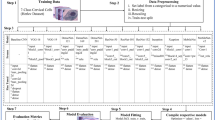Abstract
Cervical Cancer most often affects women and is a feared disease worldwide. It occurs due to the abnormal growth of cells in the cervix and slowly spreads to other organs in the body. Cervical cancer can be cured completely if detected at an early stage. Various cervical screening methods are available, but early screening with low-cost Pap smear tests is the key to curing. Knowing about this cancer, if we contribute to detecting it at an early stage, may help to save a life. For accurate disease diagnosis and prompt care at an early stage of cell development, automated Pap smear cell recognition and classification are critical. Various computer-aided systems are available that use hand-crafted features of Pap smear images to categorize them into normal and abnormal cells. Deep learning classification methods have been the top choice as their approaches have attained state-of-the-art in tumor identification. In this article, deep learning is used in two different ways. In this approach, pre-trained models as feature extractors and different machine learning algorithms are utilized for classification; the second approach used is transfer learning using pre-trained models to classify Cervical Cancer images. Using the first method with a pre-trained model as a feature extractor, ResNet-50 achieves the highest classification accuracy of 92.03%. Using the second approach of fine-tuning pre-trained models, Google Net has given the highest classification accuracy of 96.01%.






Similar content being viewed by others
Data availability
Enquiries about data availability should be directed to the authors.
References
Alaslani M, Elrefaei L (2018) Convolutional neural network based feature extraction for iris recognition. Int J Comput Sci Inf Technol, 10(2)
Alom MZ, Taha TM, Yakopcic C, Westberg S, Sidike P, Nasrin MS, Van Esesn BC, Awwal AAS, Asari VK (2018) The history began from alexnet: a comprehensive survey on deep learning approaches, arXiv preprint arXiv:1803.01164
Chen W, Li X, Gao L, Shen W (2020) Improving computer-aided cervical cellsclassification using transfer learning basedsnapshot ensemble. Appl Sci 10:7292. https://doi.org/10.3390/app10207292
Goodfellow I, Bengio Y, Courville A (2016) Deep learning. MIT Press, Cambridge
Han J, Kamber M (2000) Data mining: concepts and techniques. Morgan Kaufmann
Hijazi S, Kumar R, Rowen C (2015) Using convolutional neural networks for image recognition. Cadence Design Systems Inc., San Jose
Hull R, Mbele M, Makhafola T, Hicks C, Wang SM, Reis RM, Mehrotra R, Mkhize-Kwitshana Z, Kibiki G, Bates DO, Dlamini Z (2020) Cervical cancer in low and middle-income countries. Oncol Lett 20(3):2058–2074
Jantzen J, Norup J, Dounias G, Bjerregaard B (2005) Pap-smear benchmark data for pattern classification. In: Proceedings of the NiSIS 2005: nature inspired smart information systems (NiSIS), EU Coordination Action, Albufeira, Portugal, 1–9 January 2005
Joutsijoki H, Henry M, Rasku J, Aalto-Setälä K, Juhola M (2016) Error-correcting output codes in classification of human induced pluripotent stem cell colony images. BioMed Res Int 1–13
LeCun Y, Bengio Y, Hinton G (2015) Deep learning. Nature 521(7553):436
Lin H, Hu Y, Chen S, Yao J, Zhang L (2019) Fine-grained classification of cervical cells using morphological and appearance based convolutional neural networks. IEEE Access 7:71541–71549
Lozano R (2007) Comparison of computer-assisted and manual screening of cervical cytology. Gynecol Oncol 104(1):134–138
Mbaga AH (2015) Pap smear images classification for early detection of cervical cancer. Int J Comput Appl 118(7):10–16
Mizianty M, Kurgan L, Ogiela M (2008) Comparative analysis of the impact of discretization on the classification with naïve bayes and Semi-Naïve bayes classifiers. Machine Learning and Applications, ICMLA '08. In: Seventh international conference
Riana D (2015) Extraction and classification texture of inflammatory cells and nuclei in normal pap smear images. In: 2015 4th international conference on instrumentation, communications, information technology, and biomedical engineering (ICICI-BME)
Sharma M (2016) Classification of Clinical Dataset of Cervical Cancer using KNN. Indian J Sci Technol. https://doi.org/10.17485/ijst/2016/v9i28/98380
Sreedevi MT (2012) Papsmear image based detection of cervical cancer. Int J Comput Appl 45(20):35–40
Witten IH, Frank E (2005) Data mining practical machine learning tools and techniques, 2nd edn. Morgan Kaufmann, San Fransisco
World Health Organization (2018) United States Centers for Disease Controland Prevention, CDC Foundation, George W. Bush Institute, ``Improving data for decision-making: A toolkit for cervical cancer prevention and control programmes,'' World Health Org., Geneva, witzerland, Tech. Rep
Xing F, Yang L (2016) Robust nucleus/cell detection and segmentation in digital pathology and microscopy images: a comprehensive review. IEEE Rev Biomed Eng 9:234–263
Zhang L, Kong H, Ting Chin C, Liu S, Fan X, Wang T, Chen S (2014) Automation-assisted cervical cancer screening in manual liquid-based cytology with hematoxylin and eosin staining’. Cytometry A 85(3):214–230
Zhang L, Lu L, Nogues I, Summers R, Liu S, Yao J (2017) DeepPap: deep convolutional networks for cervical cell classification. IEEE J Biomed Health Inf 21:1633–1643
Acknowledgments
This research work is funded by Department of Science and Technology (DST), India. Authors are thankful to DST for the support.
Funding
The authors have not disclosed any funding.
Author information
Authors and Affiliations
Corresponding author
Ethics declarations
Conflict of interest
The author declares that they have no conflict of interest.
Informed consent
Informed consent was obtained from all individual participants included in the study.
Human and animal rights statement
This article does not contain any studies with human participants or animals performed by any of the authors.
Additional information
Publisher's Note
Springer Nature remains neutral with regard to jurisdictional claims in published maps and institutional affiliations.
Rights and permissions
Springer Nature or its licensor (e.g. a society or other partner) holds exclusive rights to this article under a publishing agreement with the author(s) or other rightsholder(s); author self-archiving of the accepted manuscript version of this article is solely governed by the terms of such publishing agreement and applicable law.
About this article
Cite this article
Kalbhor, M.M., Shinde, S.V. Cervical cancer diagnosis using convolution neural network: feature learning and transfer learning approaches. Soft Comput (2023). https://doi.org/10.1007/s00500-023-08969-1
Accepted:
Published:
DOI: https://doi.org/10.1007/s00500-023-08969-1




